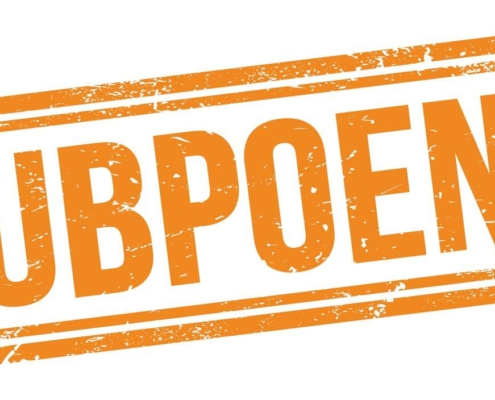The Superiority of In-Person Depositions: Mastering Non-Verbal Cues for Enhanced Legal Communication
Effective communication significantly relies on our ability to read and interpret the subtle cues exhibited by others. This skill set, essential in both personal and professional settings, enables us to adapt our behavior and responses to better align with the motivations and feelings of those around us. Mastery of this ability can be particularly pivotal in legal settings, such as during in person depositions and video remote depositions, where the stakes are high and the subtleties of human behavior can reveal more than words alone. In this context, live in person depositions are notably superior to video remote depositions.
As a civil litigation and trial attorney with nearly two decades of experience, I’ve taken hundreds of live in person depositions and examined witnesses in dozens of bench and jury trials. My extensive background has provided me with an understanding of the nuances in legal communication, particularly the importance of non-verbal cues in depositions. In this discussion on the effectiveness of in-person versus video remote depositions, I shared insights from my professional practice that underscore the significant advantages of being physically present. This experience has taught me that live, in-person depositions offer a strategic advantage by allowing attorneys to fully engage with and interpret the subtle behaviors of witnesses, which are often pivotal in assessing credibility and reliability of testimony.
The advantages of conducting in person depositions are manifold. Firstly, the physical presence of the witness and legal teams in the same room creates a dynamic environment where attorneys can fully engage with and respond to the nuanced behaviors of the witness. Body language, eye movement, posture, and even minute changes in facial expressions are all critical in assessing the credibility and reliability of testimony during an in person deposition. These non-verbal cues can often indicate discomfort, hesitation, or uncertainty about the questions being asked, providing an insightful layer of communication that goes beyond spoken words.
Moreover, the immediacy of the physical setting allows for better control of the in person deposition environment. Attorneys can manage the pace and flow of questioning more effectively when they are in the same room as the witness. They can make real-time assessments and adjustments based on the witness’s behavior and the overall atmosphere in the room. This level of interaction is less fluid and more challenging to achieve through a video remote deposition, where technical issues such as delays, poor video quality, or connectivity problems can detract from the subtleties of the interaction.
In addition to the enhanced observational capabilities that come with being physically present, there is also a psychological element that favors in person depositions. Witnesses are likely to feel the weight of the proceedings more acutely when physically present in a formal setting surrounded by the legal parties involved. This setting can lead to more forthright and thoughtful responses, which are crucial in legal proceedings where every detail can be significant.
Furthermore, the formal atmosphere of an in person deposition implicitly upholds the seriousness and solemnity of the legal process, reinforcing the responsibilities and the gravitas of truthful testimony. This psychological and environmental pressure is often diminished in video remote depositions, where participants may feel a sense of detachment from the process.
While advancements in technology have made video remote depositions a viable alternative—especially useful in situations where distance or health concerns prevent face-to-face meetings—the intrinsic benefits of live, in person interactions remain unmatched. The ability to directly engage with all participants and witness firsthand the subtlest of cues provides a significant strategic advantage. It ensures a more thorough and effective examination and contributes to the overall integrity and efficacy of the legal process. Thus, whenever possible, opting for an in person deposition is the superior choice, leveraging the full spectrum of human communication skills to achieve a clearer, more accurate understanding of the testimony being given.
Understanding Basic Human Behavior
The foundational step in effective interpersonal communication, particularly in legal contexts such as in person depositions and video remote depositions, is establishing a baseline of an individual’s typical behaviors. This involves observing and noting how a person usually carries themselves, including their habitual postures, facial expressions, and gestures. For example, an individual might habitually scratch their head when thinking deeply or cross their arms as a natural comfort gesture rather than a display of defensiveness.
In live, in person depositions, this baseline is essential for interpreting deviations that may indicate tension or an attempt to withhold information. Observing these deviations in real-time and in a shared physical space enhances the clarity and immediacy of these behavioral cues. Attorneys and observers can detect subtle shifts in behavior—such as a witness who normally uses expansive gestures suddenly becoming stiff and guarded—that might be less perceptible or completely lost in a video remote deposition.
Video remote depositions, while useful in certain circumstances, can diminish the effectiveness of this observational strategy. Technical limitations such as camera angles, lighting, and video quality can obscure important nonverbal cues. Delays in transmission can also disrupt the natural flow of conversation and interaction, potentially leading to misinterpretations of a witness’s responses or demeanor. Moreover, the physical separation inherent in video remote depositions may reduce the psychological impact of the proceedings on the witness, possibly affecting the authenticity and spontaneity of their responses.
Thus, the advantage of conducting in person depositions lies not only in the ability to closely observe and respond to these behavioral cues but also in maintaining the formal and psychological environment that underscores the gravity of the legal process.
Interpreting Deviations and Clusters of Gestures
When deviations from established baseline behaviors occur, particularly when several changes cluster together, they can provide critical insights into a person’s underlying emotions or intentions. For instance, during an in person deposition, if a witness avoids eye contact while simultaneously tapping their foot and clenching their fists, these behaviors, when observed together, likely indicate anxiety or frustration. The ability to detect and interpret these clusters is significantly enhanced in a live, in person deposition setting where the full range of nonverbal cues is immediately visible and can be analyzed in real-time.
Conversely, video remote depositions can limit the ability to perceive these important cues. Technical restrictions such as camera framing might only show the witness’s face, missing out on hand movements or foot tapping. Additionally, video quality issues can blur subtle facial expressions, and any lag in video or audio can disrupt the natural timing and flow of responses, making it difficult to accurately assess behavior clusters. These limitations can impede the effective reading of a witness’s demeanor, potentially leading to incomplete or erroneous interpretations of their emotional state and reliability during a video remote deposition.
Reading Body Language
Body language is a crucial element in understanding a person’s confidence and emotional state, which is particularly important during depositions. Observing a witness’s posture can be very revealing; for example, slumped shoulders may suggest that a person feels defeated or insecure, while an open stance with shoulders back could indicate confidence. Facial expressions are also vital in this analysis, as micro-expressions that briefly appear on someone’s face can convey emotions like contempt or approval that might not be explicitly stated.
The benefits of live, in person depositions are pronounced in these contexts, as observers can view these body language cues without obstruction. In contrast, video remote depositions can significantly hinder this observational capability. The limited field of view provided by a camera can miss crucial postural cues, and subtle facial expressions might not translate well through digital media due to compression and lower video quality. Furthermore, even slight delays in streaming can interfere with the timing and flow of these expressions, making it challenging to capture the fleeting micro-expressions essential for accurate emotional interpretation. These limitations can impede the depth and accuracy of understanding a witness’s demeanor, potentially affecting the outcome of legal proceedings during a video remote deposition.
Acoustic Cues: Voice and Speech Patterns
The tone, pitch, and pace of a person’s voice are key indicators of their emotional state, which can be critical during depositions. A higher pitch in someone’s voice may suggest nervousness or excitement, while a monotone delivery could be a sign of disinterest or emotional detachment. Similarly, rapid speech may reflect eagerness or anxiety, while a slower pace could suggest sadness or uncertainty.
In a live, in person deposition, these auditory cues are heard clearly and in real-time, allowing attorneys and judges to make more accurate assessments of a witness’s reliability and state of mind. This direct and uninterrupted auditory feedback enables a deeper understanding of the witness’s responses.
Conversely, video remote depositions can diminish the effectiveness of interpreting these vocal nuances. Technical issues such as poor audio quality, delays, or disruptions in the transmission can obscure or alter these important cues. For example, a delay in audio might make a response seem hesitant when it was not, or compression can flatten the tone of voice, stripping away nuances that might indicate the witness’s true feelings. These limitations can lead to misinterpretations, potentially affecting the fairness and outcome of the legal process during a video remote deposition.
Mirror Neurons and Emotional Energy
Humans possess mirror neurons, specialized brain cells that allow us to empathize with others by internally mirroring their emotions. For example, seeing someone smile can activate our mirror neurons for smiling, eliciting feelings of happiness within ourselves. This neurological capability plays a crucial role in emotional connectivity and can be instrumental in accurately interpreting a person’s true feelings during interactions.
The concept of emotional energy within a space also significantly impacts our emotional state. When physically present with others, we can sense and be influenced by the emotional energy they emit—positive energy can be uplifting, while negative energy can be draining. This palpable atmosphere is an essential aspect of understanding and connecting with others.
In the context of a legal deposition, these aspects are critical. Live, in person depositions enable full engagement with these emotional and energetic cues. Being in the same room allows participants to experience and interpret these subtle energies and expressions directly, which can be vital for assessing the truthfulness and reliability of testimony.
Conversely, video remote depositions can hinder this process. The separation created by screens and the lack of physical presence can dilute the transmission of emotional energy and subtle nonverbal cues. Technical limitations, such as video lag and poor image quality, further exacerbate this issue by obscuring or distorting visual feedback, making it difficult to engage with and accurately interpret the witness’s emotional state. This reduction in sensory input can lead to a less nuanced understanding of the witness, potentially impacting the effectiveness of the video remote deposition.
Intuitive Cues Beyond the Observable
Observing visible cues plays a crucial role in understanding others, yet a significant part of reading people effectively hinges on intuition—those gut reactions that provide insights beyond the apparent. Intuitive insights, often emerging as a vague sense or a sudden hunch, can be remarkably accurate in assessing someone’s feelings or intentions. Developing a keen sense of intuition requires an acute awareness of these internal signals and trusting them to inform our judgments and interactions.
In legal settings, such as depositions, the benefits of live, in person depositions are particularly pronounced when it comes to harnessing intuition. Being physically present allows attorneys and other observers to immerse fully in the nuances of the witness’s behavior and the atmosphere of the room, which can significantly enhance the intuitive reading of the situation. This direct and dynamic interaction facilitates a deeper, more instinctual understanding of the witness’s credibility and emotional state, which is often critical in legal outcomes.
On the other hand, video remote depositions can significantly limit the effectiveness of intuitive judgments. The physical separation and the mediated nature of video can obscure subtle cues that trigger intuitive insights. Additionally, technical issues such as camera angles, video quality, and delay can disrupt the natural flow of interaction, making it challenging to pick up on the subtle signals that often inform our gut reactions. This barrier can result in a less comprehensive assessment of the witness and potentially impact the integrity of the video remote deposition.
Listening to Intuition
Listening to your intuition encompasses more than just reacting to a gut feeling; it involves a sophisticated blend of emotional intelligence and rational thought processes to gain a deeper insight into interpersonal dynamics. Intuition can alert you to whether someone is trustworthy or if a situation holds more complexity than it initially appears. For example, you might experience a sudden unease during a conversation—recognizing and considering these intuitive responses is vital for making well-informed decisions in both personal interactions and professional transactions.
In the specific context of a deposition, the advantages of being physically present are significant. Live, in person depositions allow legal professionals to directly observe and interact with the witness, facilitating a richer, more intuitive engagement. This setting enhances the ability to perceive subtle cues that might not be as apparent or might be altogether missed in a video remote deposition. These cues, from slight hesitations to changes in demeanor, can significantly inform the evaluation of a witness’s testimony.
Conversely, video remote depositions can hinder the intuitive process. The physical disconnect and potential technical limitations such as camera framing, sound quality, and internet connectivity issues can obscure crucial non-verbal cues and interrupt the natural flow of dialogue. These barriers can dilute the intuitive sense legal professionals rely on to gauge sincerity and intention, potentially affecting the depth of understanding necessary for critical legal assessments.
Techniques to Enhance Reading People
Observing a person’s body language and non-verbal cues provides invaluable insights into their confidence and emotional state—insights that are particularly critical during legal depositions:
- Notice Posture and Movement: The way someone holds themselves can reveal much about their confidence and mental state. A witness’s posture during an in person deposition can subtly communicate whether they are relaxed and open or tense and closed off.
- Observe Facial Expressions: Facial expressions are windows into a person’s emotions. Recognizing these cues can help legal professionals understand underlying feelings that may not be expressed verbally.
- Listen to Tone and Pitch of Voice: The sound of a person’s voice, including changes in tone and pitch, often signals their emotional condition, providing clues about their sincerity or stress levels.
- Watch for Physical Responses: Body language, such as hand clenching or broad gestures, can indicate a range from nervousness to openness, offering clues to a witness’s emotional state and truthfulness.
- Tune into Emotional Energy: The overall energy a person emits can significantly influence the atmosphere of the room. Sensing and interpreting this energy can guide how attorneys approach their questioning and interaction during an in person deposition.
- Trust Intuitive Insights: Gut feelings or intuitions can be powerful indicators in understanding a witness’s motives or truthfulness, especially when corroborated by other observations.
The benefits of conducting in person depositions are significant in this regard. Being in the same room with a witness allows attorneys and judges to directly perceive and interpret these non-verbal cues without the mediating layer of technology. This direct observation enables a more accurate and holistic assessment of the witness’s credibility and emotional state.
Conversely, video remote depositions can compromise the ability to fully capture these non-verbal cues. Technical issues such as poor video resolution, inadequate camera angles, and audio delays can obscure subtle but critical cues like slight shifts in posture or fleeting facial expressions. Additionally, the physical separation and sometimes impersonal nature of video conferencing can diminish the ability to gauge and respond to the emotional energy in the room. These factors can make it more challenging to form a comprehensive understanding of the witness’s testimony, potentially affecting the outcome of the video remote deposition.




























